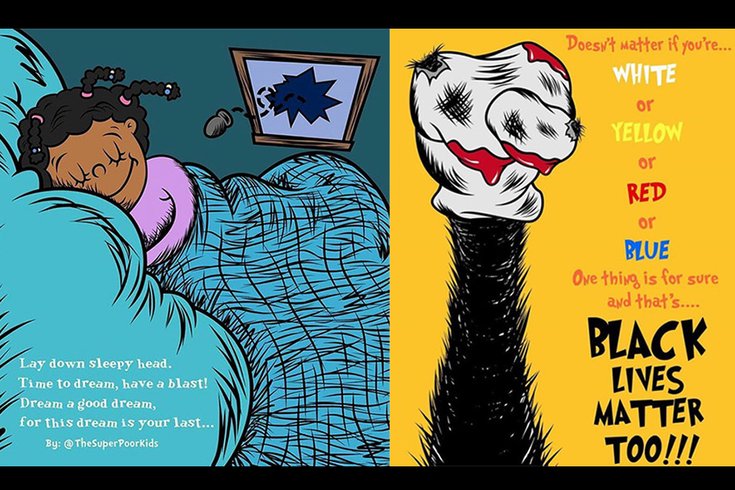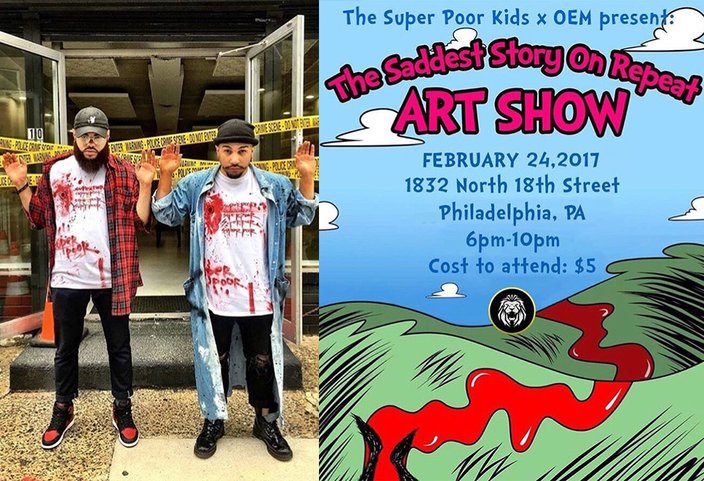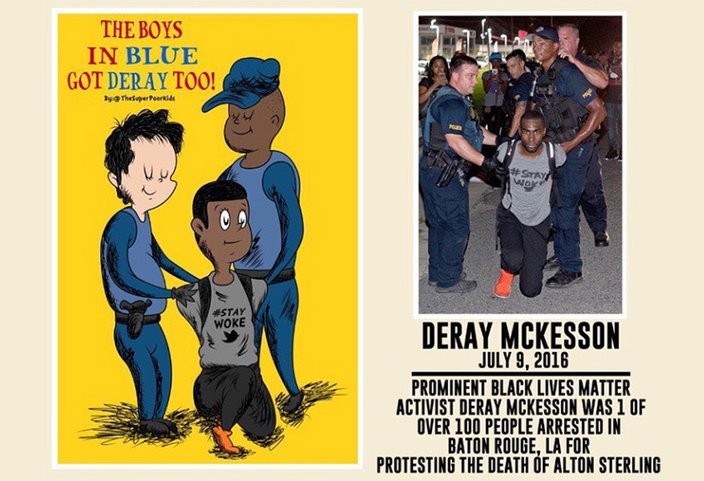
February 23, 2017
 Images courtesy/The Super Poor Kids
Images courtesy/The Super Poor Kids
The Super Poor Kids illustrate police brutality through their iconic Dr. Seuss-themed art.
Lou Reyes remembers the excitement he felt two years ago when his social media feeds erupted at the news of a long-lost Dr. Seuss manuscript.
Post after post heralded the posthumous release of "What Pet Should I Get?" But scattered among the collective giddiness were other posts detailing the police-involved killings of black men — and the anger, pain and loss the deaths prompted.
Reyes found it a jarring juxtaposition.
"It was interesting to see those two subjects contrast and clash, at least on my timeline," Reyes said. "It was like, damn, this is crazy to think that this is all happening at one time."
So Reyes, 28, and his younger brother, Jay, 27, combined the two themes for an art series. Known as The Super Poor Kids, the Camden artists created 12 Dr. Seuss-inspired sketches depicting the victims of police-involved killings and related events.
Their work, dubbed "The Saddest Story On Repeat," will be on display Friday at an art show being hosted by Only Elite Matters, a startup company managed by Temple University students. The show will run from 6-10 p.m. at 1832 N. 18th Street. It costs $5 to enter.
The deaths of Alton Sterling and Philando Castile — on back-to-back days last July — prompted The Super Poor Kids to complete the series, which had been placed to the side. They felt the killings were happening so rapidly that victims' lives could not be properly celebrated before the next killing and social media hashtag, Lou Reyes said.
That stood in stark contrast to the legacy of Dr. Seuss, who began his career as a political cartoonist. Many of Theodor Seuss Geisel's works highlight his views on social issues, including "The Sneetches," a 1961 book that satirizes discrimination.
"Everybody was so excited about Dr. Seuss," Lou Reyes said. "From the older generations down to the younger generations, it was so iconic. Dr. Seuss' books and his name will live on forever. I took that and merged it with the victims of the Black Lives Matter movement.
"I figured, hey, these hashtags are getting a solid week, if that, of social media time and then they're swept under the rug. If we can kind of twist it in a Dr. Seuss kind of way, maybe their names could live forever as well."
Only Elite Matters and the The Super Poor Kids will host “The Saddest Story on Repeat” Art Show from 6 to 10 p.m. Friday in North Philadelphia.
The Super Poor Kids unveiled the pieces on social media last September, rolling out a new piece every day for nearly two weeks. They've gained a solid following, with 13,500 followers on Instagram and another 1,700 on Twitter.
They followed with an exhibit at Open Space in Northern Liberties that featured an entrance obstructed by police tape, a chalk outline of a slain "Cat In the Hat," and Skittles and Arizona Iced Tea — the items Trayvon Martin was carrying the night he died.
The response was overwhelming, the artists said. Much of it was positive, with people sharing the pieces across social media. Several teachers said their work enabled them to address a difficult topic with young children.
But their work drew criticisms, too. Some people questioned why they didn't depict police officers killed in the line of duty. Others accused them of trying to profit from the deaths of the victims. The cruelest hurled insults.
Lou Reyes said he initially was taken aback — and angered — by some of the negative responses. But his brother convinced him that the myriad responses meant one thing – their art had made an impact.
In his eyes, their work had sparked conversation — and a much-needed one.
This artwork by The Super Poor Kids illustrates the arrest of Black Lives Matter activist Deray McKesson during a protest in Louisiana after the death of Alton Sterling.
"This is an uncomfortable topic and we want you to feel uncomfortable," Jay Reyes said. "This topic is not for you to just look at and be like, 'That is cool.' ... You should feel some type of way about it. Everyone should."
That's why Sam Colon, founder of Only Elite Matters, wanted to showcase the art at a venue near Temple's campus. His startup is a creative agency that also organizes collaborative events featuring work he believes will resound with people.
Colon, 26, has anticipated collaborating with The Super Poor Kids since viewing their exhibit last October.
"We sat on it because we wanted to present it to our people at the right time," Colon said. "Black History Month is the perfect time to represent it to a new market. With so many people in such a small place, I felt like it would make an impact."
He still remembers the emotions he felt when he first saw the art at the Open Space exhibit last fall.
"When you walk in, you're like 'Oh man, this is a lot,'" Colon said. "Then you get the chills. Then you start thinking about the things that happened. You relive the moments — where you were at, how you saw it, or your perspective.
"I just think it's amazing because it creates that dialogue. ... Whether it's connecting or dividing people, it's still a conversation that needs to be had."
 Images courtesy/The Super Poor Kids / Only Elite Matters
Images courtesy/The Super Poor Kids / Only Elite Matters Image courtesy/The Super Poor Kids
Image courtesy/The Super Poor Kids